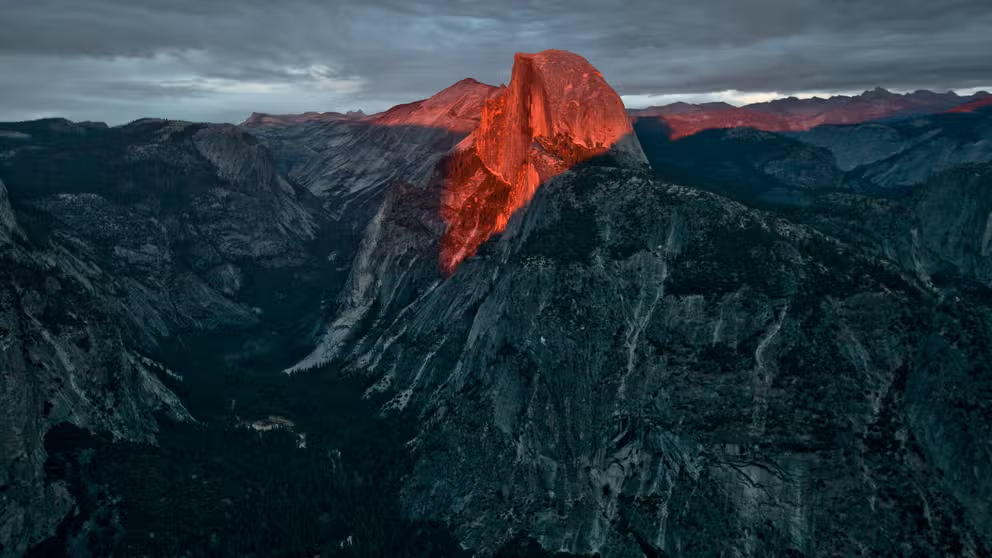7 amazing reasons to visit Yosemite National Park
FOX Weather honors National Parks Week by spotlighting Yosemite National Park.
Yosemite National Park
Yosemite National Park is America's second-oldest national park.
It is hard to choose just seven reasons to visit Yosemite National Park, 150 miles east of San Francisco. It is home to towering granite cliffs that rise over crystal clear streams and 3,000-year-old giant sequoia trees seem like newcomers compared to the rugged 100 million-year-old rock.
Grizzly bears, elk, moose and bison graze through the expansive meadows of wildflowers while hikers cool off in the spray of thousand feet of waterfalls thundering through hidden canyons. In 2014, a wildlife cam caught a Sierra Nevada red fox for the first time in a century.
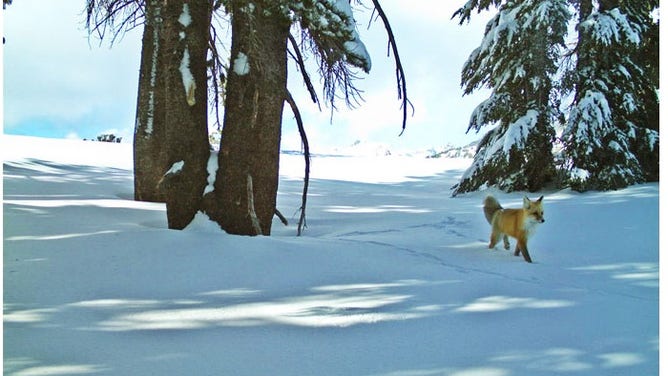
A wildlife camera in Yosemite caught the first glimpse of a Sierra Nevada red fox in almost 100 years.
(National Parks Service)
Waterfalls, firefalls and moonbows
Spring waterfalls are plentiful and impressive as the Sierra snows melt. Peak snow melt is during May and June.
One of the largest falls in the world is Yosemite Falls with a 2,425-foot drop. The water flows over it from November to July. When the creek volume dwindles, visitors can see it is made up of three separate cataracts. Dogwoods at the base bloom in May. In winter, an ice cone forms at the base of the upper fall.

Yosemite Falls is one of the tallest waterfalls in the world.
(Brant Ward/San Francisco Chronicle via Getty Images / Getty Images)
When the water flow is high and overnight temperatures dip below freezing, usually in the spring, the creek can flow with slush. The slush is called frazil ice and forms when the waterfall mist freezes and floats down the creek.
The park lists many hikes to enjoy the feature up close. For a wider view head to Sentinel Meadow. From home, you can check out the falls from a Yosemite Conservancy webcam.
Look for moonbows or lunar rainbows in the spring and early summer when the sky is clear and the moon full. Waterfall mist captures moonlight to create a colorful, nocturnal treat.
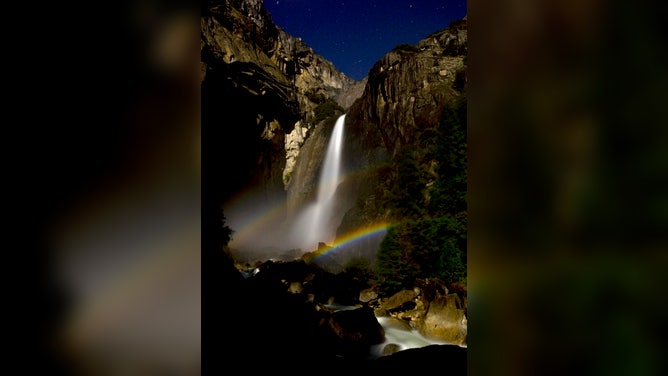
Springtime in Yosemite means that it is a perfect time to observe a double lunar rainbow or "moonbow" created in the mist of lower Yosemite Fall while the full moon rises over the top of the granite walls of the Yosemite Valley.
(Mark Boster/Los Angeles Times via Getty Images / Getty Images)
In February, Horsetail Fall looks like it is on fire as it reflects orange sunsets. The thousand-foot waterfall flows from December to April. Visitors can see it from the road.
FIRE IN THE SKY: YOSEMITE'S ‘FIREFALL’ DRAWS THOUSANDS TO WITNESS NATURE'S MAGNIFICENT SPECTACLE
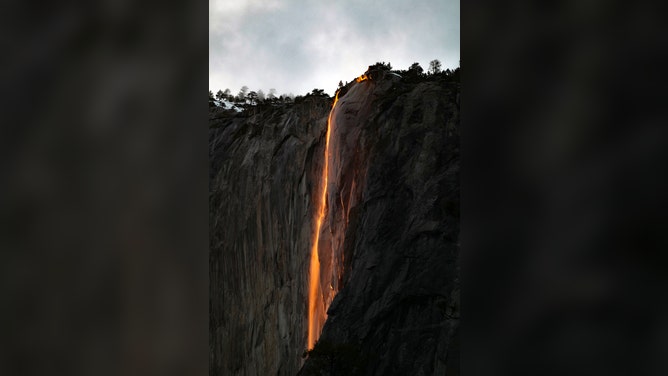
Horsetail Falls at sunset in February look more like firefalls.
(Nick Ut/Getty Images / Getty Images)
Bridalveil Fall is one of the first grand waterfalls visitors encounter. The best time to see the powerful fall is spring, but it generally has water flowing year-round. The Bridalveil Trail is closed for repair until the fall.
Dire-thru sequoias
The park is home to the Mariposa Grove of giant sequoias. Over 3,000 years old, Grizzly Giant still towers over visitors along with the California Tunnel Tree (only 1,000 years old). Park officials cut the tunnel in 1895 to allow horse-drawn carriages through.

Tunnel Tree, tunnel cut through a sequoia, Yosemite National Park.
(Andia/Universal Images Group via Getty Images / FOX Weather)
The first tunnel tree, Wawona Tree, was cut through in 1881 as a tourist attraction, said the National Parks Service. At 2,100 years old, 234 feet high and a diameter was 26 feet it fell after a tough winter in 1968-69. The tunnel itself was 7 feet wide, 9 feet hight and 26 feet long and park officials suspect it may have had something to do with the tree’s demise.
The grove hosts over 500 giant sequoias. It wasn’t officially a part of the National Park until 1906. A shuttle thorough the giants resumes May 26. But, even in the winter when it is closed to cars, the trails are open and welcome visitors on cross country skis and snowshoes.
Visitors can also go to the Merced and Tuolomne Groves which each have two dozen giants. The groves are less traveled as they are only accessible by trail.
El Capitan
One of the most iconic features in the park is El Capitan, an imposing granite rock. Its sheer faces rise 3,600 feet off the valley floor and reaches 7,569 feet above sea level. A live webcam offers a glimpse.
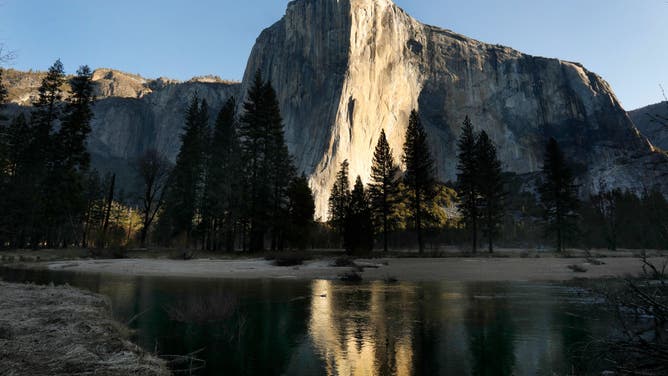
EL Capitan at sunrise in Yosemite National Park.
(Carolyn Cole / Los Angeles Times via Getty Images / Getty Images)
Native Americans called the rock To-tock-ah-noo-lah which translates to "Rock Chief" or "Captain". The first record of white settlers in the area was 1851 when the local militia, Mariposa Battalion, pursued Indians into the valley. The battalion members called the monolith El Capitan, Spanish for "The Captain", according to Encyclopedia Britannica.
Initially thought unclimbable, an expedition took 45 days over a year to set fixed ropes and ascend the peak for the first time in 1958. In 2017, Alex Honnold became the first to solo climb the mountain without ropes as filmed in the Oscar winning documentary "Free Solo."
Half Dome
Another famous site in Yosemite is Half Dome. The crystallized magma chamber of a volcano pushed through thousands of feet of earth. Wind, rain and ice eroded the rocks that once covered the gigantic rock, rounded on three sides with a sheer vertical face.
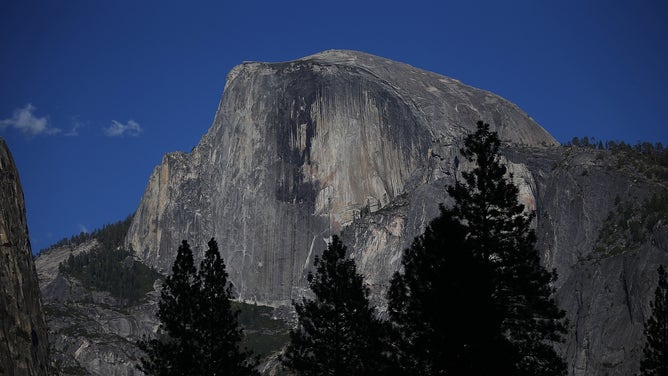
Half Dome rising almost 5,000 feet above the valley floor.
(Justin Sullivan/Getty Images)
Visitors can hike the formation that sits almost 8,800 above sea level and 5,000 feet above the valley floor, but you have to plan ahead. Only 300 (225 day-hikers and 75 overnight backpackers) a day are allowed to hike beyond the sub-dome when the cables are up from the Friday before Memorial Day to Columbus Day in October.
Visitors can sign up for a lottery to get reservations in March for day-hikes at recreation.gov. Or, apply two days before a planned visit to claim any canceled reservations. Overnight backpackers need to apply for a wilderness permit.
Everyone can view Half Dome and the Yosemite Valley floor from the Yosemite Conservancy’s webcam.
History
Yosemite earned federal protection even before it became the third National Park in 1890. President Lincoln issued the Yosemite Grant in 1864 to reserve the natural land for "public use, resort and recreation." It marked the first time in history that the federal government protected a scenic natural area, wrote the Department of the Interior.
The scenes inspired artists like photographer Ansel Adams and naturalists and writers like John Muir (founder of Sierra Club). The natural beauty prompted Muir to lobby the government to establish the area as a National Park.
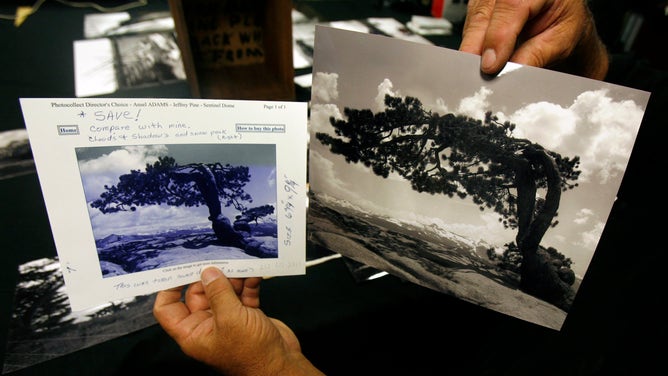
An Ansel Adams photo of a Jeffrey pine on Yosemite's Sentinel Dome.
( Eric Paul Zamora/Fresno Bee/Tribune News Service via Getty Images / Getty Images)
A concessioner tried to create the "Switzerland of the West" in the 1920s and installed toboggan runs, skating rink and ski jump. The Interior Department said the Olympic Committee considered Yosemite for the 1932 Winter Olympics but chose Lake Placid, New York instead.
In 2021, 3.1 million people visited the park, 75% of them arrived May though October. While the park roads can be crowded during those months, anyone looking can always find solitude in nature. Over 1,00 square miles, 95% of Yosemite, are designated "Wilderness," according to the Wilderness Act.
Glaciers formed the valley
Rivers and glaciers carved out 3,000 feet of the rock in eastern California, which is now the Yosemite Valley. The glacial idea was first suggested in a series of magazine articles in the 1870s by John Muir, said Britannica.com.
Vistas
The 1,189 square mile park is nestled in the Sierra Nevada Mountains. Vistas offer, arguably, unparalleled views of the shear natural beauty that California has to offer.
The Tunnel View from the east end of the Wawona Tunnel on Wawona Road captures El Capitan, Bridalveil Fall and Half Dome.
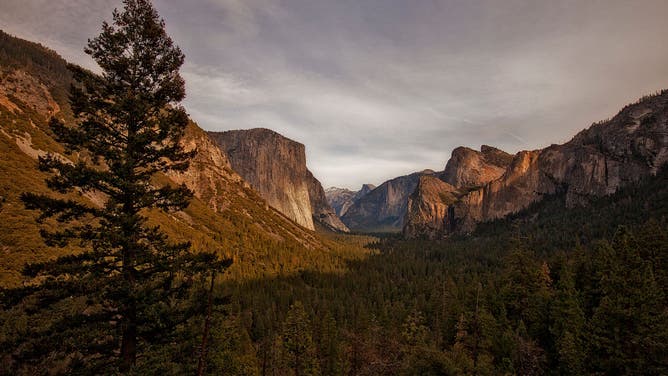
The Tunnel View of Yosemite Valley was made famous by photographer Ansel Adams.
(Ted Soqui/Corbis via Getty Images / Getty Images)
From Glacier Point, visitors can take in the Yosemite Valley, Half Dome and Yosemite Falls. The point even offers a wheelchair accessible trail 3,214 feet above the valley.
The park’s features and activities accessible by car and wheelchair are available in the Accessibility Guide.
The park makes it easy for everyone to monitor its weather via webcam.
You can also check the FOX Weather app for Yosemite Valley weather.
